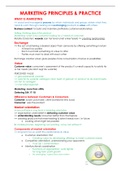MARKETING PRINCIPLES & PRACTICE
WHAT IS MARKETING
=> social and managerial process by which individuals and groups obtain what they
need & want through creating and exchanging products & value with others
Business context: to build and maintain profitable customer relationships
Selling: thinking about the product
Marketing: what is my costumer looking for // needs of costumer
Relatie tss klanten: waarde aan het leven (niet enkel fysiek) => creating relationships
Exchange
=> the act of obtaining a desired object from someone by offering something in return
- At least two parties
- Each must hold something of value to offer
- Parties must want to deal with each other
Exchange creates value: gives people more consumption choices or possibilities
Value
Customer value: consumer’s assessment of the product’s overall capacity to satisfy his
or her needs (de klant zegt de waarde)
PERCEIVED VALUE
=> gewaardeerde waarde
=> verschil tss waarde verkregen door bezit of gebruik vh product & de kost/moeite
om het te verkrijgen
=> niet altijd objectief
Marketing: more than utility
Oefening DIA 17-18
Difference between Customers & Consumers
Customer: buyer, purchaser, client (someone who buys)
Consumer: uses the product
Market orientation
(more profitable in long term) ≠ marketing orientation
=> organisation-wide belief in delivering customer value
=> understanding needs consumer better than themselves
=> creating products that meet existing & latent needs now / in future
Looking what might be possible
Bv mobile phones, beginning not wanting ->now not without it
Components of market orientation
=> long term focus: profit thru relationships & value
Customer orientation: first
o Creating value by developing offerings to meet customer needs
Competitor orientation: understanding your opponents
o Voor zijn / samenwerken
Interfunctional coordination
o Functions of organization: work tighter
for long-term profit growth
o Na overtuiging -> great story waar maken
,Customer centricity
- Not trying to please ALL customers
- Fulfilling needs in a PROFITABLE way
o Pushen, niet goed op LT
o Trying for a select group of people
Market sensing
- If you develop market orientation
- Understanding strategic implications of market
Marketing’s intellectual roots
=> Marketing is a result of influence of:
Industrial economics influences
- Matching of supply & demand (price, quantity)
- Theories of income distribution, scale of operation, monopoly, competition, …
Psychological influences
- Consumer behaviour, motivation research, information processing
- Understanding: persuasion, consumer personality, customer satisfaction
Sociological influences
- How groups of people behave:
o Demographics (age/gender)
o Class (social positions)
o Motivation
o Customs (groups behave)
o Culture
- Communication through opinion leaders -> influence (Instagram)
Anthropological influences
- Qualitative approaches in researching consumer behaviour
o Ethnography
o Netnography
o Observation
- Human nature
- Behaviour of subgroups
Computer science influences
- Digitization, recommendation systems, apps, …
o Algoritme Netflix
o Plaats producten supermarket
Development of marketing
Production period
- Physical products & supply
- Demand exceeded supply (mr V dan A)
- Na industriële revolutie: 1890-1920
Sales period
- Personal selling
o Supported by: marketing research and advertising
o verkopen
- Na WOI 1920-1950
, Marketing period
- Focus on customer’s needs
o Customer: 1ste plaats
- Na WOII
- 1950-1980
Societal marketing period
- Focus social & ethical concerns
o Gezondheid, recycleren
- Information revolutions: 1980-present
Differences: sales & marketing
TOP OF THE ICEBERG:
Advertisement (the only thing that we see)
A lot more going on
Bv Zara: fast fashion
=> making selling unnecessary (selling itself)
MARKETING SALES
Product pull Product push
o Estimate & stimulate demand o Promote customer purchase of
o Understanding & communicating with offering
customer o Selling after making the product
Long-term satisfaction of customer needs Short-term -> deel v proces
Greater input into customer design of waardecreatie (niet ontwikkelen ervan)
offering Lesser input
High focus on stimulation of demand Low focus -> more focused on meeting
existing demand
Verschil verminderd: Key account management (H16) -> combinatie van beide!
APPLICATION & RELEVANCE
1. Physical products 6. Film, music & theatre
Cars, candy K3 zoekt K3, Lady Gaga
2. Services 7. Places
Google, ING Antwerpen, vakantie
3. Retail 8. Ideas
Media markt, Zara Don’t drink & drive
4. Experiences 9. Charities & non-profit
Disney, Pairi Daiza Warmste week, Ice bucket
5. Events challenge
Olympic, Tomorrowland 10. People
Trump, Kardashian
=> MARKETING APPLIES ANYWHERE BUYERS HAVE A CHOICE
MARKETING PROCESS
=> You need a lot of things in marketing
=> Can’t control everything (vb the price)
=> Marketing everywhere in organization
Employees: part-time marketers
, What do marketers do?
- Aware
- Active leraner
- Able
- Accomplished
- Authoritative
Generate customer insights to
develop marketing strategy
Reform reputation
- Building trust
- True dialogue with customers
- Personalizing offerings
- Asking for forgiveness if judgement
- Showing respect
Laws of marketing -> general theory
Reilly’s Law: place for stores
Engels’s Law: income increases, income spent miscellaneous items increases & food
decreases
WHY WHAT WHERE WHEN HOW
Bahaviour buyer, seller
Institutional framework (vb government)
Consequeces of society of buying & selling
GENERALIZATION
1) Advertising: direct & + effect on market sales
2) Selective advertisement: direct & + effect on individual company (brand) sales)
3) Elasticity of selective advertising on company sales is low
o Limited effect in raising sales
4) Increasing store shelf space: + effect sales of non-staple grocery items
o Unplanned purchases (impulse) -> more space = more likely to buy
5) Distribution: + effect on company sales
o More location = more sales
Trial & error -> digitalization helps
Exchange
=> Marketing organization + customer inputs
Customer specify needs, marketers adapt, customers buy




